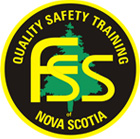Hydraulic Hose Crimper
Hazards Identified
Pinch points, crushing injuries, flying debris
Hazard-Specific Personal Protective Equipment
Safety glasses, gloves
Hazard-Specific Training
Supplier training specific to the crimper being used
Safe Work Practice
- Do not use this equipment unless you have read and thoroughly understand the manufacturer’s manual, and been oriented by a competent person. (Most crimpers have a designated operator who has been trained by the supplier.)
- Secure the equipment on a stable work surface.
- Ensure that the work area is clean and uncluttered.
- Ensure that the proper die is on the crimper for the fitting you are crimping.
- Do not insert/remove dies while the power is on.
- When crimping, make sure hands and fingers are clear of the machine.
- Do not strike hardened dies with any hardened instruments, such as hammers or wrenches, as this may cause them to shatter or break.
- Do not over pressurize.
Regulations, Standards and References
Occupational Safety General Regulations, Manufacturer’s Manual or Operator Instructions for the specific Hose Crimper being used
